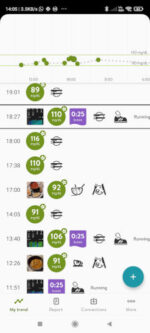One of the things I put in place from day one is to track everything.If you don’t know what’s happening, you can’t progress and you can’t keep yourself accountable.
As a diabetic, one very important thing to track is your glycemia. You can’t know how your body behaves if you don’t keep an eye on it. You don’t need a fancy continuous monitoring system (though the idea of those is attractive). A simple cheap glycemia tester is sufficient. It’s more important to do it often. It’s not even important that the tester’s absolute numbers are super accurate. What’s informative is the variation: you want to see your blood sugar go down over time; you want to see spikes; you want to see that you progress.
When I wanted to get my blood sugar under control, I was testing between 12 and 20 times a day: before each meal, 1 hour after meals, 2 hours after meals, at wake time, at bedtime, before and after exercise. The more you test, the better you’ll understand what’s happening and the effect of what you do on your glycemia.
To track most things I use an app called mySugr. The main reason I settled on it is that it’s Bluetooth enabled for some testers so I don’t need to type numbers after each test (it gets tedious after a while to type things). The picture on the left shows what I record: test results, exercise, meals, weight, blood pressure, etc. I even take photos of everything I eat.
What’s missing in mySugr is synchronisation with Google Fit to keep everything in the same place. For several months I copied the numbers from mySugr to Google Fit, but eventually gave up because it was taking too much time.
One advantage of testing a lot is that you can test the effect of what you do. For example, you can test the effect of eating a specific kind of bread. Or design your breakfast menu to get as much energy and proteins as possible, but keeping your blood sugar low (for me it’s eggs). Test before you eat, then every 1/2 hour after the mean for 3 hours and you’ll know exactly what it does to your body. Then you can decide if it’s acceptable for you.
Another advantage of testing a lot is keeping you honest. It’s easy to try to cheat and get the right numbers. Even if you don’t show them to anyone. But that’s not how you’ll manage to get your problem under control. If you test a lot, you can’ get through the cracks and you’ll have to see what’s happening, even if you don’t like it (you might have to give up your favourite desert).



